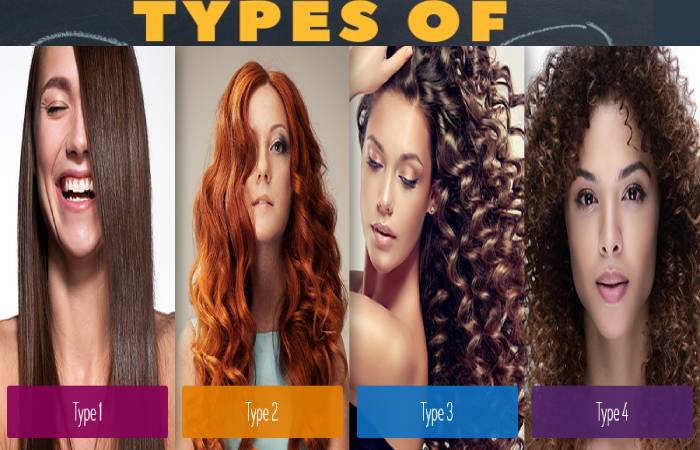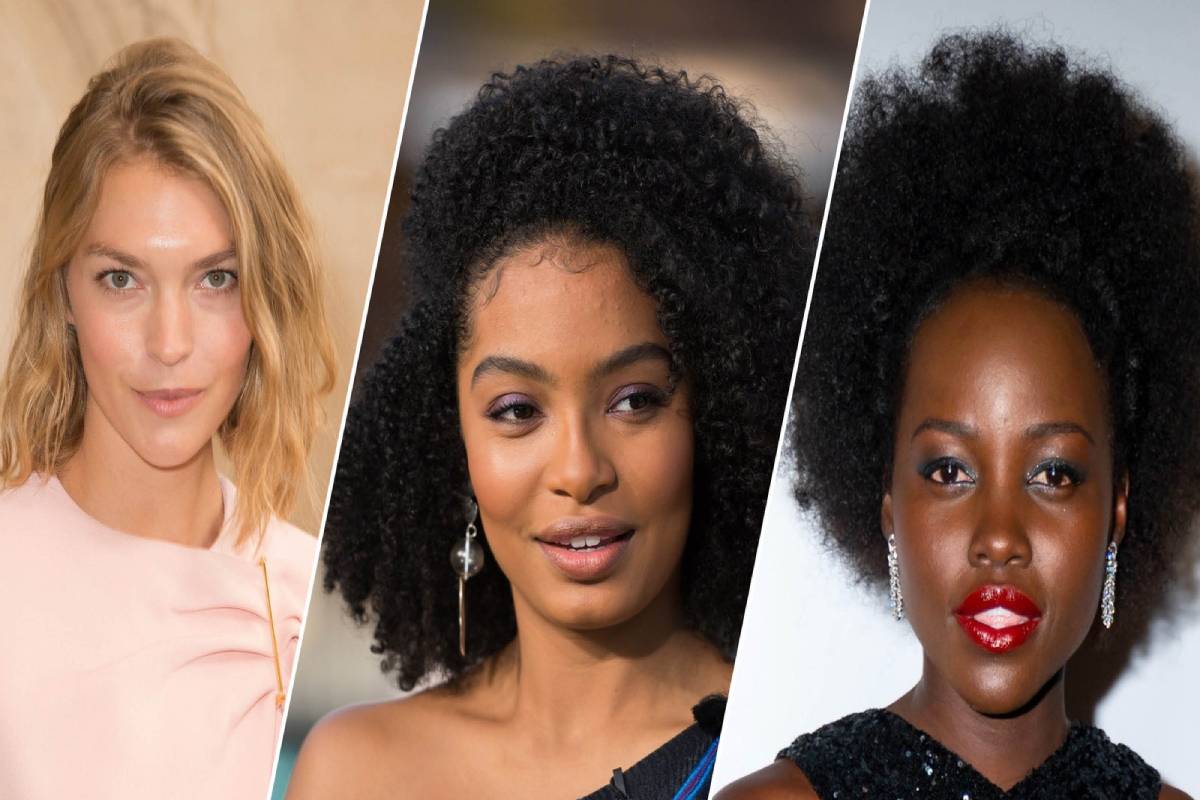Table of Contents
Curl Type Definition
Curl type determines by the shape of the follicle that your hair grows out of from your scalp.
The shape also identifies your curl pattern that the strands of hair make, whether they kink, curve, or wind around themselves into spirals.
So you have a combination of, say, kinky, Coily, wavy, and curly. Identifying your curl shape and pattern is best determined while your hair is sopping wet.
What are the Types of Curl Type?

First of all, we must know that there are different types of curls, but we will start from the smoothest to the waviest, so here they go:
Type 1: Smooth Hair
We are ready! The first thing you have to know is that, before understanding the different types of curls. There is Type 1, where the hair is completely straight, and in some cases, it begins to take a slight curl.
Type 1 divide into 3 subtypes, which are:
1A
- This type of hair is the straightest of all. It does not have volume and falls completely straight from its beginning on the scalp to the tip.
- This type of hair is known to be the most miniature hairstyles for being the finest of all.
1B
- From this, the hair begins to take shape and has a little more volume than the previous one.
- It varies between coarse and fine and is more malleable than Type 1A hair since it is easier to hold a curl with the iron if desired.
- This type of hair has some waves at the ends, unlike the previous one where the hair, we have already mentioned, falls utterly smooth from the beginning to the end.
1C
- Type 1C is generally smooth and, in some areas, has no waves but a bit of curve. It has that “perfect tousled” look without the need to add heat tools like an iron.
How to Care
Washing: This type of hair must be washed more frequently than the others as it quickly becomes greasy. Choose light shampoos and conditioners that give volume without heavy oils in the composition, primarily type 1A.
Shampoos give the right effect with therapeutic clay that helps the hair stay clean for longer. Do not ignore the exfoliation of the scalp so that your hair feels more “free.”
Care: A light spray of the straightening effect can eliminate frizz from straight hair (pay attention to the fact that the composition does not contain large amounts of oils).
Fix: Straight hair tolerates drying at high temperatures better than other hair types, but it is still better to prefer drying at cooler temperatures and always use thermal protection.
Hairstyle: Straight hair should choose the “cascade” haircuts to create the effect of movement. Type 1A thin hair will not hold curls and volume for long, but the hair will work correctly with braids or modern updos.
Type 2: Wavy Hair
The next type of hair, known as Type 2B, is where the waves start to come out. In this, the hair knows to be neither so dry nor so greasy. Here, the hair begins to take shape and acquires more volume than in the previous one.
Three types will continue to give us an idea of knowing what kind of curls I have?
2A
- It has different loose strands in which other “S” shaped waves show, although still somewhat light. This type of hair still feels fine.
2B
- This type of hair has more defined waves than all the previous ones, but they still very close to the scalp so that the hair does not fluff.
2C
- This type of hair becomes wider and can sometimes start from the beginning of the scalp. This type of hair can be more accessible to style, iron, and return to its natural shape if desired.
How to Care
Washing: The main task is to make the hair have volume while eliminating porosity and the effect of “just woke up.” It is necessary to use shampoos, conditioners, and masks with a moisturizing effect but not bulky. The suitable products are with the extracts of fruits, vegetables, and herbs.
Care: To avoid over-drying the hair and to “fix” the moisture well, apply hair lotions based on light oils (grapeseed, linseed, mustard) from the centre part towards the ends of the hair. Several times a week, include products with profound hydration effect in hair care. Primarily type B and C hair absorb moisture well.
Arrangement: You should not blow-dry your hair until it is scorched as that spoils the natural waves causing porosity. It is better to blow dry your hair naturally (or use a blow dryer with cold air). Do not use healthy styling products (especially for type 2A) because the hair becomes heavier, “stretches,” and loses its volume.
Hairstyle: Choose haircuts that do not have clear lines and sharp transitions. Otherwise, you will have to flatten it to make it look good always. The waves come apart very quickly, so keep in mind that the hairstyle is unlikely to return to its original state after being tied for a while in a ponytail or braids. The most persistent curls are type 2C.
Type 3: Curly Hair
This type of hair is naturally curly and has an “S” shape. In this type of hair, curls form naturally without manipulating an iron or a heating device. This type of hair tends to be dry thanks to texture as oils hair creates are not broad reach.
Its ends for all the curves and waves it travels. Like the previous ones, it divides into three types:
3A
- This hair type features loose but somewhat large curls. They are a bit silky in texture. The curls are very defined and do not need any product or heat to form.
3B
- It consists of curls that are more wavy and pronounced than Type 3A. Most women with dark complexions fall into this category.
- Although it tends to have much frizz, the hair is moderately defined, so it needs products such as gel or styling creams.
3C
- It has tighter and smaller curls and high texture. The hair strands find together, which is known as bunching.
- It recommended to use these products to define the curls, although they express themselves in some cases.
How to Care
Washing: The objective is the same as in wavy hair: to retain the moisture as much as possible in the hair (curly hair is very prone to dryness). You can choose shampoos and conditioners specifically for this type of hair, with highly hydrating oils and ingredients in the composition. Choose shampoos that do not contain sulfates as these dry out the hair and are therefore not suitable for curly hair.
Care: Use the conditioners and hair masks without rinsing to help the curls take the desired shape (but not the masks with silicone since they seal the hair cuticle and prevent moisture penetration into the hair). It is also better dry hair naturally. If you must use a hairdryer, the air should be cold, and a diffuser nozzle will help keep your curls in shape. The best oils for hair are jojoba, almond, argan, coconut, olive. Hairdressers recommend sleeping on a silk pillowcase because it protects hair from excessive friction by preventing frizz.
Arrangement: It is best to style curly hair when it is still wet. If you miss this moment, your hair will end up very tangled and impossible to comb. This type of hair is complicated to straighten with ironing, and the process itself harms its structure (it dries out very quickly).
Hairstyle: The shorter the hair, the stronger it will curl. At the salon, you should immediately explain that it is unnecessary to moisten the hair before cutting it; The proper cut can determine by working only with dry curls and using suitable techniques for them.
Type 4: Afro Hair
These types of curls are minimal, dense, and not define like Type 3. Another difference between these two types of curls is that, when wet, Type 4 curls maintain their shape while Type 3 curls. When wet, hair can become straight or wavy.
They divide into three:
4A
- This curl type of hair is somewhat tight and takes a cylindrical shape. They are usually the width of a pencil, and unlike the other categories of Type 4, the 4A usually falls and has defined curls.
4B
- To tell the difference between 4B and 4C hair, 4Bis usually more defined at the ends, even if its roots are not. Hair looks tighter, and its texture is dry.
4C
- This type of hair takes the shape of a “Z” and does not accept any definition. The texture of the individual strands ranges from delicate and fine to coarse and coarse.
- This type of hair has known to shrink to more than half its regular length.
- Knowing what type of curls you have can be a challenge for many, but once you see each aspect of your hair, everything will be more comfortable.
- In this way, you will know what products your hair needs to make it look better than ever.
How to Care
Washed: It considers that this curl type of hair should not wash too often. Shampoos should be as delicate as possible. Organize shampoo-free days: apply conditioner to wet hair and rinse. It will give it the necessary moisture and gently cleanse your hair.
Care: Disciplining curls can do with the help of styling products such as oils or lotions. However, it is almost impossible for type 4C curls to lend themselves to modification. Pay attention to the ends as they are fragile on this type of hair and need additional moisture.
Arrangement: Drying it with cold air and a diffuser nozzle is the best option for this type of hair, but only after drying it to the maximum with a towel. Drying wet hair with a blow dryer will cause the curls to lose their defined shape.
Hairstyle: Keep in mind that the shorter the hairstyle, the more chaotic the curls will be. The ideal hair length for curls is shoulder length and below.
We hope that our advice is valuable and you make the most of it. Please share with us which recommendations you found most suitable for your hair type.

